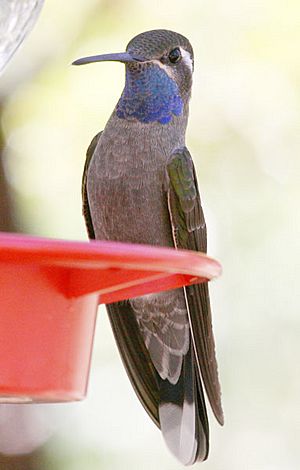Blue-throated mountaingem facts for kids
Quick facts for kids Blue-throated mountaingem |
|
|---|---|
 |
|
| Male | |
| Conservation status | |
| Scientific classification | |
| Genus: |
Lampornis
|
| Species: |
clemenciae
|
The blue-throated mountaingem is a beautiful hummingbird. It's also known as the blue-throated mountain-gem or blue-throated hummingbird. Its scientific name is Lampornis clemenciae. This amazing bird belongs to the hummingbird family, called Trochilidae.
Contents
What Does It Look Like?
The blue-throated mountaingem is a pretty big hummingbird. It grows to be about 11.5 to 12.5 centimeters (about 4.5 to 5 inches) long. It weighs between 6 and 10 grams. That's like weighing a few paper clips!
This hummingbird has a dull green color on its back. Its belly is a medium gray. You can easily spot a white stripe behind its eye. There's also a smaller stripe from its beak, next to a dark cheek patch.
Its tail feathers are a shiny blue-black. The tips of the outer two or three pairs of tail feathers are white. The male bird has a bright, shiny blue patch on its throat. This patch is called a gorget. Females do not have this blue throat patch; their throats are plain gray.
Where Does It Live and What Does It Do?
The blue-throated mountaingem lives in mountain forests in Mexico. During the summer, you might find it in wet, wooded canyons. These areas are called the Madrean Sky Islands. They are found in southeastern Arizona, southern New Mexico, and western Texas in the United States. They also live in northeastern Sonora, Mexico.
Some of these hummingbirds spend the winter at special feeding spots in southeastern Arizona.
How Do They Sing?
Male blue-throated mountaingems sing two kinds of songs. One is a simple "peep song." It sounds like a squeaky wheel and lasts about 1 second. The other is a quiet but complex "whisper song." This song can last as long as 8 seconds.
Female hummingbirds are also known to sing during the breeding season. They do this to get the attention of males. The male's song is special because it uses sharp, strong trills and clicks. It also has a very wide range of sounds, from low to very high pitches.
These birds also use sounds that humans can't hear. These are called ultrasonic vibrations. They don't use these sounds to talk to each other. Instead, they might use them to find and confuse insects they want to eat.
How Do They Build Nests?
The male hummingbird does not help with building the nest or raising the babies. The female builds the nest all by herself. She uses soft plant fibers. She holds them together and attaches the nest to a support using spider silk. She steals this silk from spider webs!
The nest can be attached to a tree branch, a flowering plant, a fern, a vine, or even a rock shelf. Sometimes, she uses human-made things like a wire or a nail. The outside of the nest is often covered with green moss to help hide it. If moss isn't available, she might use moss-like lichens.
Blue-throated hummingbirds often build their nests over water, especially flowing streams. The female lays two white eggs. The eggs hatch in about 17 to 19 days. The young birds leave the nest when they are about 24 to 26 days old.
If conditions are good, a female can raise up to three groups of babies each year. She often builds each new nest right on top of the old one. This can create tall "nest towers" at places where they often nest.
What Do They Eat?
Like other hummingbirds, the blue-throated mountaingem eats nectar from flowers. Nectar is a sweet liquid. They also catch insects while flying. Sometimes, they pick insects off plants.
In winter, if flowers are scarce, they might drink sap. This sap comes from holes that sapsucker birds drill into trees.
See also
 In Spanish: Colibrí gorjiazul para niños
In Spanish: Colibrí gorjiazul para niños


